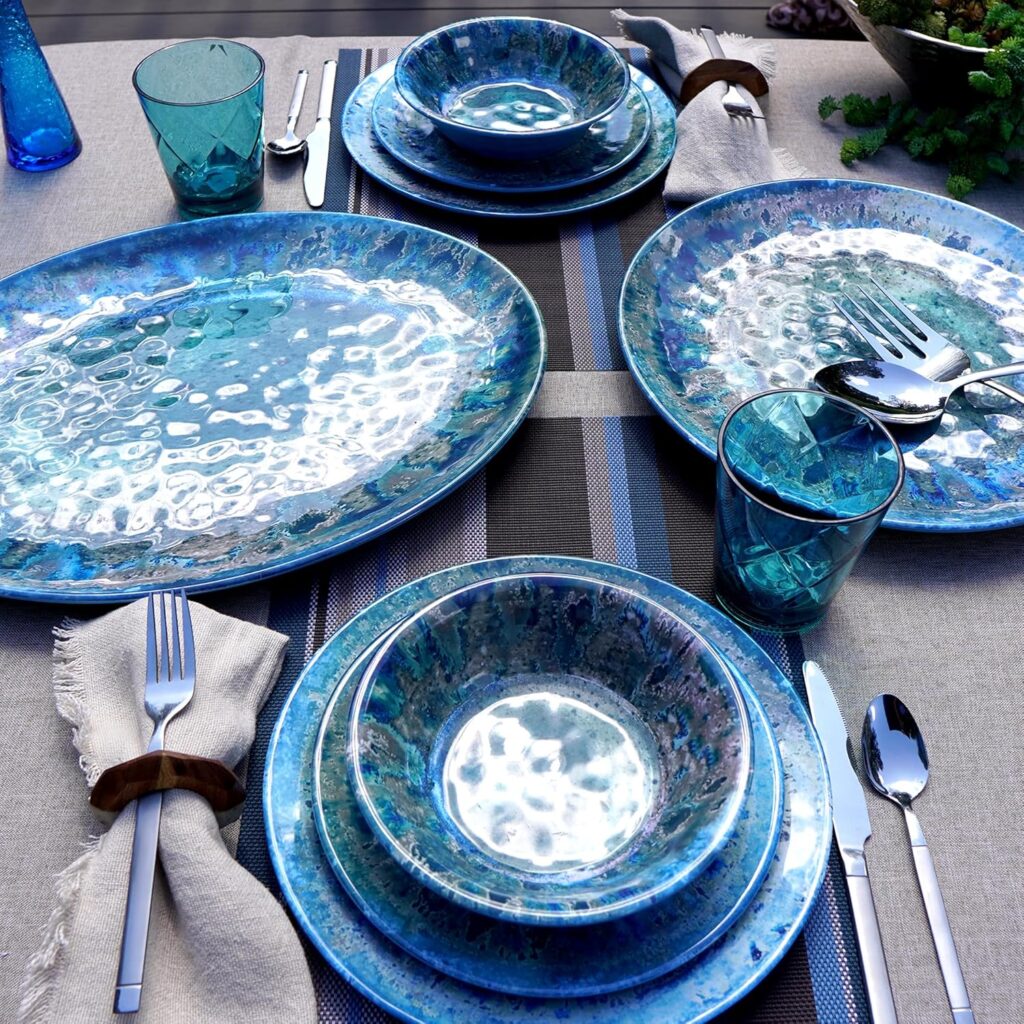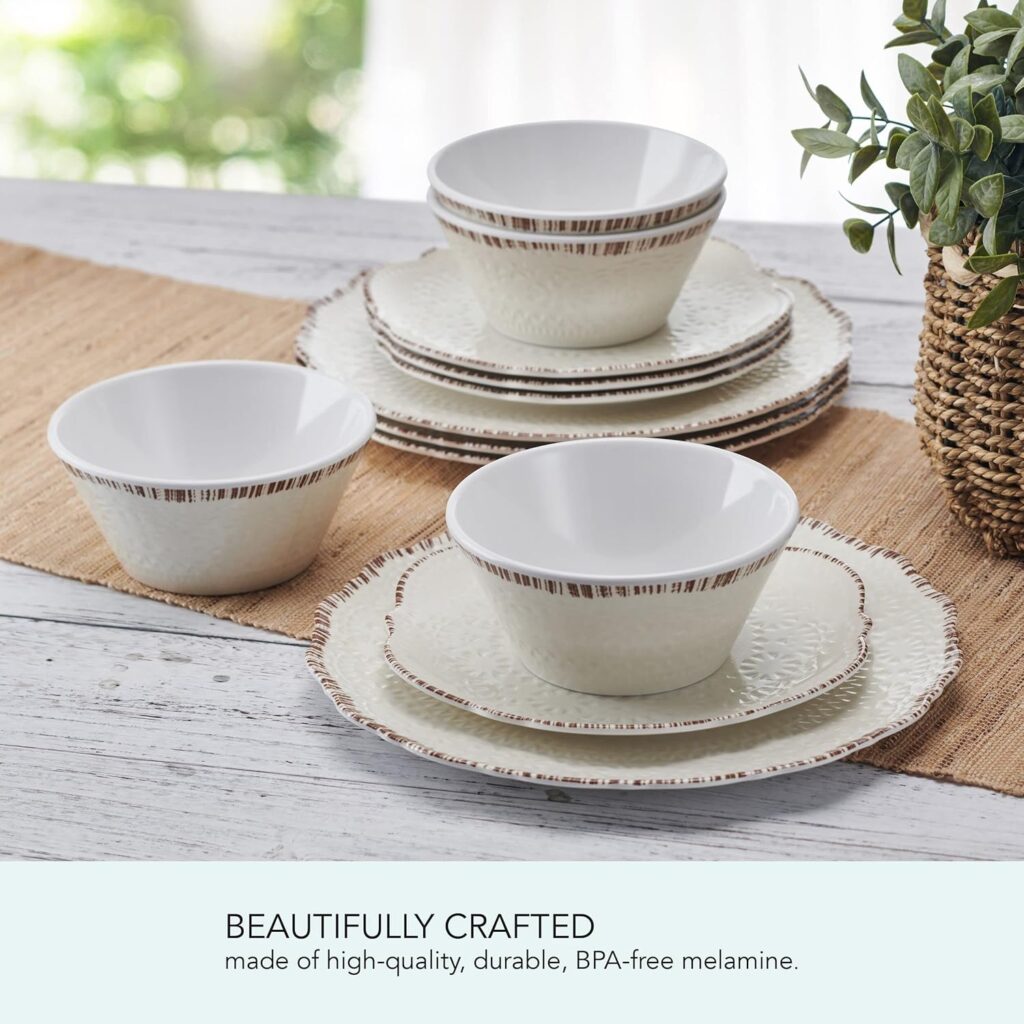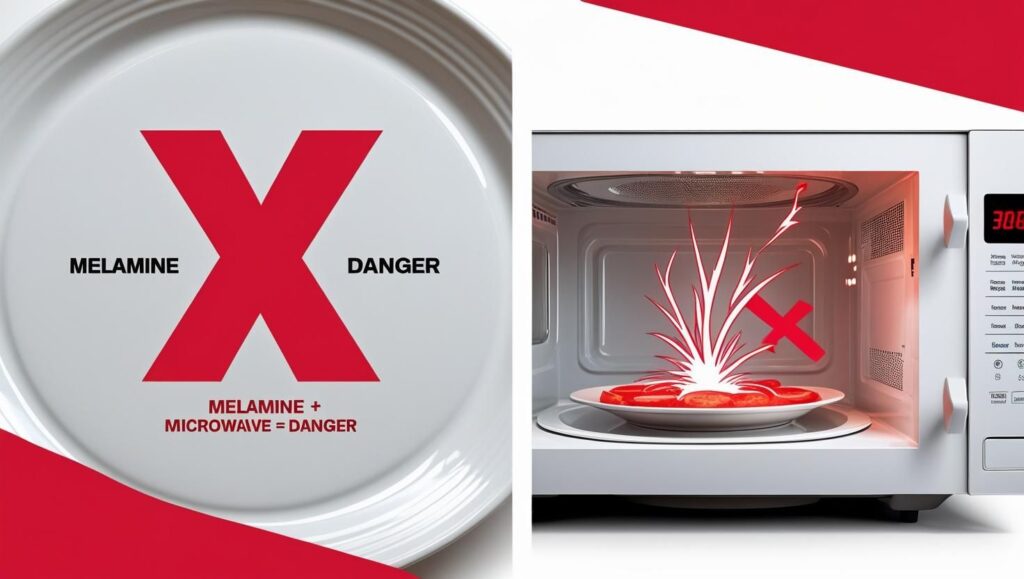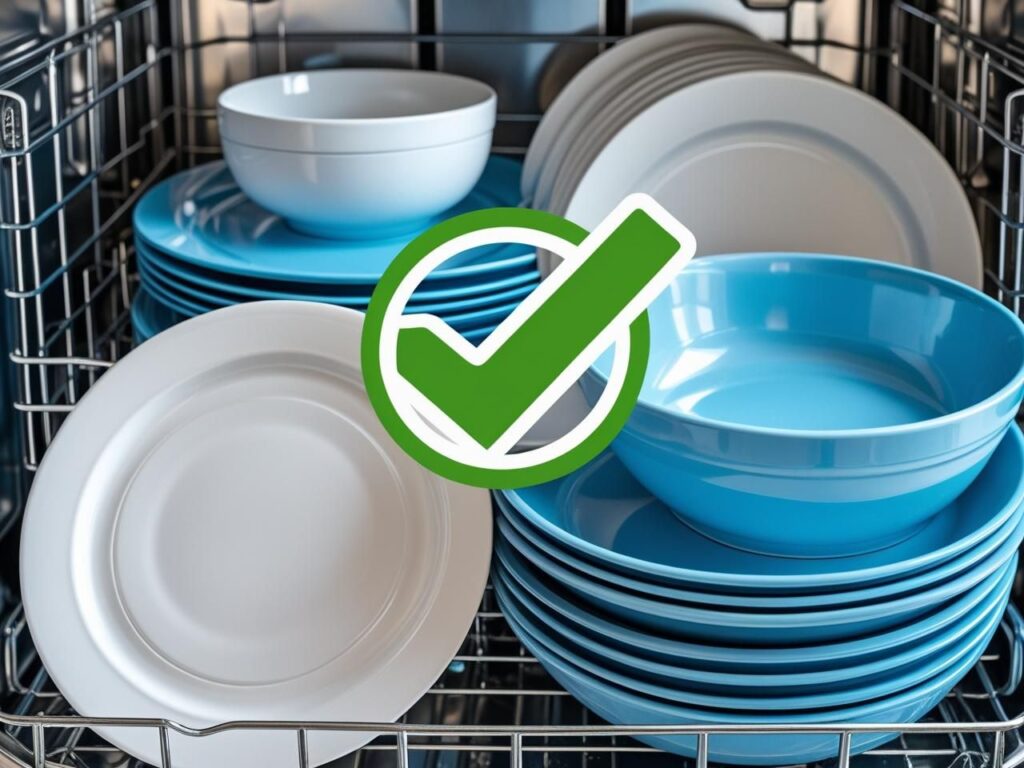What You Need to Know:
Melamine dinnerware cannot go in the microwave because it releases toxic chemicals when heated above 160°F (71°C). Microwaves easily exceed this temperature limit, causing melamine to leach formaldehyde and other harmful substances into your food. Even brief heating can cause chemical migration, making melamine dishes unsafe for any microwave use. Always transfer food to microwave-safe glass or ceramic containers before heating.
INTRODUCTION
You’re rushing through your morning routine, last night’s leftover pasta beckoning from your stylish melamine bowl.
The microwave hums invitingly, promising a quick breakfast solution. But here’s where your sophisticated dinnerware knowledge should kick in, that gorgeous melamine bowl you’re eyeing?
It’s about to become your kitchen’s worst enemy.
You see, melamine might look the part with its sleek finish and unbreakable charm, but it harbours a rather unsavoury secret.
Whilst it’s been the darling of outdoor dining and children’s tableware for decades, this plastic impostor has some serious trust issues when it comes to heat. Is melamine microwave safe?
Think of melamine as that impeccably dressed friend who looks perfect at room temperature but absolutely falls apart under pressure.
The moment you introduce serious heat, we’re talking microwave territory – things get rather toxic. Literally.
But what exactly happens when melamine meets microwave heat, and why should you care?
THE MELAMINE MYSTIQUE: UNDERSTANDING YOUR DINNERWARE
Before we dive into the heated drama, let’s get acquainted with melamine itself. This isn’t your garden-variety plastic – it’s a sophisticated thermosetting polymer that’s been fooling dinner guests since the 1950s.
What Makes Melamine Special?
Melamine resin combines melamine (a nitrogen-rich compound) with formaldehyde to create those virtually unbreakable plates and bowls you’ve grown to love.

This dinnerware is smooth, sophisticated, and seemingly indestructible. The material boasts:
- Durability: Nearly shatterproof construction
- Aesthetics: Ceramic-like appearance with vibrant colours
- Practicality: Lightweight and dishwasher-friendly
- Affordability: Budget-friendly compared to fine china
But here’s where the plot thickens. Unlike your ceramic or glass dishes, melamine has a rather dramatic relationship with heat.

Think of it as a high-maintenance material that looks stunning but requires careful handling.
THE SCIENCE BEHIND THE SIZZLE: WHY HEAT SPELLS TROUBLE
Now, let’s talk chemistry – but don’t worry, we’ll keep it as digestible as a perfectly prepared Sunday roast.
The Critical Temperature Threshold
The U.S. Food and Drug Administration (FDA) notes that melamine migration from dinnerware increases when acidic foods are held at 160°F (71°C) for extended periods.
To put this in perspective, your microwave typically heats food to temperatures between 165°F and 212°F (74°C to 100°C).
Here’s a sobering comparison:
| Heat Source | Temperature Range | Melamine Safety |
| Room Temperature | 68-72°F (20-22°C) | ✅ Safe |
| Warm Food | 100-140°F (38-60°C) | ✅ Generally Safe |
| Melamine Danger Zone | 160°F+ (71°C+) | ❌ Chemical Migration Begins |
| Microwave Heating | 165-212°F (74-100°C) | ❌ Dangerous |
| Boiling Water | 212°F (100°C) | ❌ Very Dangerous |
The Chemical Migration Process
When melamine gets too hot, it doesn’t just sit there quietly. Instead, it begins what scientists call “chemical migration” – essentially, the harmful compounds start leaching into your food.
According to FDA studies(link above) and Food Packaging Forum, this process includes:
- Formaldehyde release: The binding agent begins breaking down
- Melamine compound migration: Plastic particles transfer to food
- Accelerated degradation: Each heating cycle makes the problem worse
It’s rather like watching a beautifully painted facade slowly peeling away, except what’s underneath isn’t pretty – it’s potentially toxic.
THE MICROWAVE MELTDOWN: WHAT ACTUALLY HAPPENS
Let’s paint a picture of what occurs when you ignore the melamine microwave safety warnings.
Imagine your microwave as a rather aggressive interrogation room, and your melamine dish as an unwilling suspect about to crack under pressure.

The Immediate Effects
Within seconds of microwave heating, several things happen simultaneously:
- Hot spots develop: Microwaves create uneven heating patterns
- Chemical bonds weaken: The melamine-formaldehyde structure begins to fail
- Surface changes occur: The smooth finish may become rough or chalky
- Invisible damage: Melamine chemical leaching begins immediately
The Cumulative Damage
Here’s where things get particularly concerning. Studies show that melamine chemical migration increases with repeated exposure. Each time you microwave melamine:
- More chemicals transfer to your food
- The dish becomes more brittle and prone to cracking
- The surface degradation accelerates
- Your health risk compounds
Think of it like repeatedly washing a silk shirt in hot water, eventually, the fabric integrity completely breaks down.
BAMBOO MELAMINE: THE TRENDY IMPOSTOR
Now, you might be thinking, “What about those chic bamboo melamine dishes I’ve been eyeing?” Ah, the plot thickens further.
Is Bamboo Melamine Microwave Safe?
Despite its eco-friendly marketing, bamboo melamine contains around 20% bamboo powder, 70% melamine powder, and 10% corn starch in molding powders used for this dinnerware.
The bamboo doesn’t magically make the melamine heat-resistant – it’s still bound by the same temperature limitations.
In fact, bamboo melamine can be even more problematic because:
- The bamboo fibres can create weak points in the structure
- Additional binding agents may be present
- The natural and synthetic materials expand differently under heat
- Marketing often misleads consumers about safety
It’s rather like putting a designer label on a problematic product, the packaging might look more appealing, but the fundamental issues remain.
THE HEALTH IMPLICATIONS: MORE THAN JUST DINNERWARE
Let’s address the elephant in the room – melamine dishes leach chemicals, but what does this actually mean for your health?
Short-term Exposure Effects
Whilst occasional, minimal exposure might not cause immediate symptoms, regular consumption of melamine-contaminated food can lead to:
- Kidney stone formation
- Urinary tract irritation
- Digestive discomfort
- Potential allergic reactions
Long-term Health Concerns
Scientific research indicates that chronic melamine exposure can contribute to:
- Kidney disease development
- Bladder stone formation
- Reproductive health issues
- Potential carcinogenic effects (still being studied)
Children and pregnant women face particularly elevated risks due to their smaller body size and developing systems.
HOW LONG CAN MELAMINE GO IN THE MICROWAVE? THE DEFINITIVE ANSWER
Here’s the question that keeps popping up in kitchen conversations: how long can melamine go in the microwave? The answer might disappoint those hoping for a compromise.
The Brutal Truth: Zero Seconds
There is no safe duration for microwaving melamine. None. Research demonstrates that chemical migration begins immediately upon reaching 160°F, and microwaves easily exceed this temperature within seconds.
Even a quick 15-second reheat can:
- Initiate chemical leaching
- Create hot spots exceeding safe temperatures
- Begin the degradation process
- Compromise your health
Think of it like asking, “How long can I hold my hand in a flame?” The answer is the same – don’t do it at all.
THE DISHWASHER DILEMMA: A SILVER LINING

Now for some good news – can melamine go in the dishwasher? Generally, yes, but with important caveats.
Why Dishwashers Are Different
Most residential dishwashers operate at temperatures between 120-150°F (49-66°C), which typically stays below melamine’s danger zone.
However, some high-end models and commercial dishwashers can exceed safe temperatures.
Best Practices for Dishwasher Use:
| Do | Don’t |
| ✅ Use top rack only | ❌ Use bottom rack (hotter) |
| ✅ Select normal wash cycle | ❌ Use sanitise cycle |
| ✅ Skip heated dry | ❌ Use high-temperature settings |
| ✅ Check manufacturer guidelines | ❌ Ignore warning signs |
THE STYLE-CONSCIOUS SOLUTION: MICROWAVE-SAFE ALTERNATIVES
For those who appreciate both functionality and aesthetics, here are some sophisticated alternatives that won’t compromise your health or style:
Glass: The Transparent Champion
When considering melamine vs glass, glass emerges as the clear winner for microwave use. Borosilicate glass, in particular, offers:
- Complete microwave safety
- Temperature shock resistance
- Easy cleaning
- Timeless aesthetic appeal
Ceramic: The Classic Choice
High-quality ceramic provides:
- Excellent heat distribution
- Microwave compatibility
- Elegant presentation
- Durability comparable to melamine
Stainless Steel
For those exploring melamine vs stainless steel dinnerware, stainless steel offers unique advantages:
- Unbreakable construction
- Professional appearance
- Easy maintenance
- Versatile use (though not microwave-safe)
SPOTTING THE RED FLAGS: WHEN YOUR MELAMINE NEEDS RETIRING
Even with proper care, melamine dinnerware doesn’t last forever. Here’s how to recognise when it’s time to say goodbye:
Visual Inspection Checklist
- Cloudiness or haziness: Indicates chemical breakdown
- Rough or chalky texture: Surface degradation
- Cracks or chips: Structural compromise
- Colour fading: Heat damage
- Warping or bending: Thermal stress
The Replacement Timeline
Quality melamine can last 2-5 years with proper care, but replace immediately if you notice any damage signs.
THE SHOPPING GUIDE: CHOOSING QUALITY MELAMINE
If you’re committed to melamine for its unbreakable benefits, here’s how to shop wisely:
Look for A5 Grade Melamine
The highest quality melamine is marked as “A5 grade” and offers:
- Superior durability
- Better heat resistance (though still not microwave-safe)
- Reduced chemical migration
- Longer lifespan
Red Flags to Avoid
- Unusually cheap prices
- No grade marking
- Strong chemical odours
- Rough or uneven surfaces
- Misleading microwave-safe claims.
FREQUENTLY ASKED QUESTIONS
Stop immediately and discard the food. Allow the dish to cool, then inspect for damage. If it shows any signs of warping, cloudiness, or texture changes, dispose of it safely.
Only if the liquid temperature is below 160°F (71°C). Most freshly brewed tea and soup exceed this temperature, so it’s best to let them cool first or use ceramic alternatives.
“Melaware” is often a brand name for melamine products, but the safety concerns remain the same regardless of branding.
Most melamine can go in regular household waste, but check local recycling guidelines as some areas have specific requirements for plastic disposal.
THE VERDICT: STYLE MEETS SAFETY
Here’s the bottom line for the style-conscious and health-aware: melamine dinnerware has its place in the modern kitchen, but that place is decidedly not in your microwave.
The combination of toxic chemical leaching, irreversible dish damage, and genuine health risks makes microwaving melamine a non-negotiable no.
It’s rather like wearing a beautiful but structurally unsound shoe – it might look fantastic, but it’s not worth the injury.
Instead, embrace the sophisticated solution of transferring your food to proper microwave-safe containers.
Your health, your dinnerware, and your reputation as a savvy host will be happy with you.
CONCLUSION: THE SOPHISTICATED CHOICE
The world of microwave safe dinnerware offers plenty of stylish options that won’t compromise your health or culinary standards.
Whilst melamine serves its purpose beautifully for cold and room-temperature serving, recognising its limitations is the mark of a truly sophisticated kitchen curator.
Remember, the most elegant choice is always the informed choice.
Your guests might not notice the difference between melamine and ceramic presentation, but they’ll certainly appreciate your commitment to their safety and wellbeing.